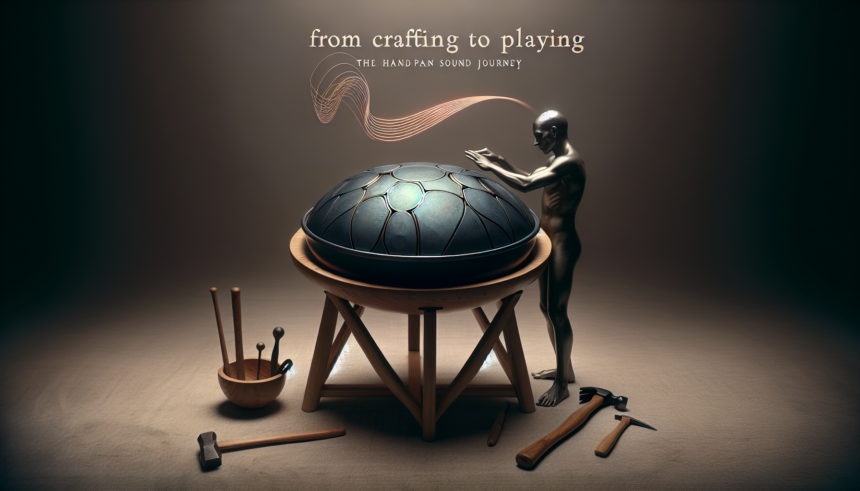The handpan is a mesmerizing instrument that has captivated musicians and listeners alike with its ethereal sound and tactile playability. This unique percussion instrument has a fascinating origin story that involves meticulous craftsmanship and an evolving musical journey for anyone who picks it up. In this article, we’ll take a deep dive into the world of handpans, exploring everything from their creation to the technique required to play them effectively.
The Birth of the Handpan
The handpan, or “hang,” was first developed in the early 2000s by Felix Rohner and Sabina Schärer in Switzerland. Inspired by the steelpan from Trinidad and the Indian ghatam, the inventors wanted to create a new instrument that was both acoustic and portable. The result was an innovative instrument consisting of two metal shells glued together to form a flattened, spherical shape. The top shell features a central note surrounded by a circle of different pitch areas, while the bottom shell generally has a single hole to amplify the sound.
Craftsmanship: The Art of Making a Handpan
Crafting a handpan is a labor-intensive process that requires skill, patience, and a deep understanding of acoustics. Each handpan is handcrafted, typically from nitrided steel, which is heated and hammer-formed into its characteristic shape. Tuning the instrument is an intricate process, often requiring the use of an electronic tuner or software to ensure each note is perfectly pitched.
After the initial shaping, artisans use hammers and other specialized tools to fine-tune the metal’s curvature and thickness. Achieving the right balance between flexibility and rigidity is crucial, as it affects the resonance and tonal quality of the instrument. Finally, the handpan is often treated with lacquer or other protective coatings to prevent rust and enhance its aesthetic appeal.
The Anatomy of a Handpan
Understanding the anatomy of a handpan is crucial for both makers and players. The central note, or “ding,” is located at the top of the instrument and is usually the lowest-pitched note. Surrounding this central note are several “tone fields,” each carefully tuned to specific pitches. On the bottom shell, many handpans feature “Gu,” a hole that helps to amplify the sound and sometimes adds a percussive element when struck.
Some handpans also include additional elements such as “shoulder” notes and “membrane” tones that offer even more possibilities for musical expression. Each handpan is unique, with different makers developing their own scales and tunings, allowing for a broad range of musical styles and expressions.
Learning to Play the Handpan
Playing the handpan can be a deeply meditative and fulfilling experience. Unlike many traditional instruments, it doesn’t require a significant amount of prior musical knowledge to begin making beautiful sounds. However, mastering the instrument does require practice, technique, and a good sense of rhythm.
Most players start by learning simple patterns and scales, gradually moving towards more complex compositions. The handpan is typically played with the hands and fingers, and different strokes can produce varying sounds. The most common techniques include the “tap,” “slap,” and “muted” notes, each offering its own characteristic sound.
Additionally, many players use both hands independently to create intricate rhythms and harmonies. The ability to improvise and explore new sound combinations is a significant part of the handpan’s appeal, allowing for endless creative possibilities.
The Handpan Community
The handpan community is a vibrant and growing group of musicians, makers, and enthusiasts who are passionate about this unique instrument. There are numerous online forums, social media groups, and events dedicated to the sharing of knowledge, techniques, and performances. Many handpan players have found that the instrument fosters a sense of connection and community, both locally and globally.
Handpan festivals and gatherings are held worldwide, offering players the opportunity to meet, learn from each other, and enjoy live music. These events often feature workshops, jam sessions, and performances by some of the most skilled handpan artists. They provide an invaluable opportunity for personal growth, musical exploration, and community building.
Conclusion
The journey of the handpan, from its meticulous creation to its expressive playability, is a testament to the power of innovation and musical exploration. This instrument, with its unique sound and tactile nature, has managed to carve out a special place in the world of music. Whether you’re a seasoned musician or a novice looking for a new creative outlet, the handpan offers a rewarding and enriching experience. Its community of makers, players, and fans continues to grow, ensuring that the handpan will remain a beloved instrument for years to come.
FAQs





